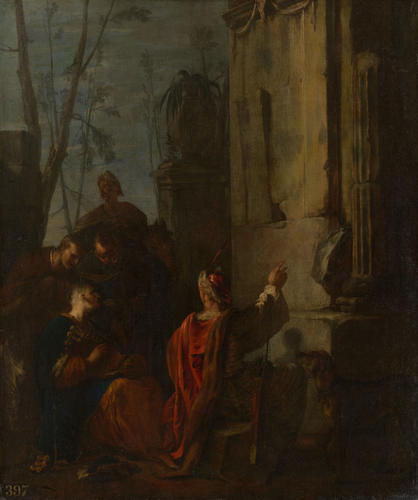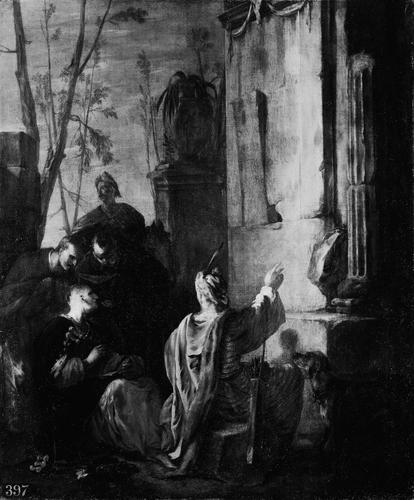Sarmatians at the Tomb of Ovid c. 1653
Oil on canvas | 105.9 x 88.3 cm (support, canvas/panel/stretcher external) | RCIN 402935
-
Schönfeld was one of the foremost painters of the German Baroque. Born in Swabia in 1609, Schönfeld was the son of a goldsmith and trained with Johann Sichelbein in Memmingen. Early drawings show the fascination with antiquity that would dominate much of his output. He was in Rome for much of the 1630s where he was influenced by Poussin's classicism; in Naples around 1638, he came under the influence of the Salvator Rosa.
In 1652 the artist returned to Germany via Venice, settling in Augsburg. There, in the early 1650s, he painted a number of pictures of soldiers; in the early 1660s he returned to the theme of treasure seeking. Schönfeld was engraved by subsequent artists such as Bartholomaus Kilian II, Philipp and Wolfgang Kilian.
In this famous composition, a group of five figures gathers next to a tomb, attempting to decipher its inscription. The mood is one of mystery and intrigue, as if this monument has been stumbled upon after weeks of searching. The shaven heads and oriental costumes reveal the figures to be Sarmatians – a people from the South Russian Steppe and Black Sea. There were originally six figures but one was erased standing to the right of the horse.
The epitaph, from Ovid's Tristia (3.3.73-6) is discernible in the Budapest version but obscured in the Royal Collection picture: hic ego qui iaceo tenerorum lusor amorum / ingenio perii Naso poeta meo; / at tibi qui transis ne sit graue quisquis amasti / dicere "Nasonis molliter ossa cubent" (I who lie here, sweet Ovid, poet of tender passions, / fell victim to my own sharp wit. / Passer-by, if you've ever been in love, don't grudge me / The traditional prayer: 'May Ovid's bones lie soft!').
Around 8 AD Ovid went into exile in Tomis, west of the Black Sea. His lascivious verses brought the poet some trouble, but he also cites an unnamed 'mistake' as the cause of his disgrace. The poet died in exile nine years later, during which time he had complained of lying 'desperately ill among the Getes and Sarmatians, without lodging or food suitable for a sick man and with no physician to feed him'. Over the centuries, there have been a numerous attempts to find the tomb of the exiled poet, with locations ranging from Romania to Hungary and Poland. According to historian J B Trapp, 'the story of Ovid's Tomb is a good example of the impulse that the uncertain and the far-off gives to the learned imagination, especially in default of sound archaeological, epigraphical or other collateral evidence'.
This group ressembles the artist's depiction of soldiers from 1653-4 (like the two in the Lichtenstein's Gemaldegalerie in Vaduz, Nr. 1231 and 1235). A diagonal composition incorporating ancient ruins fits with the artist's early Roman period of the 1650s. Though the painting is now dirty, it is easy to see that the style is somewhat rapid, similar to his Gideon Inspects his Army of 1653 (Kunsthistorisches Museum, Vienna, No. 0165).
Schönfeld has also been compared with Pietro della Vecchia, Sebastian Bourdon and Jacques Callot, but his biggest influence was Nicholas Poussin. Both Poussin and Schönfeld had love of Ovid and employed the flow of diagonals in their painting, conceiving stage-like compositions of figures inspired by a study of classical art. The moral of this painting is comparable to that of Poussin's Et in arcadia ego, its composition ressembles the version at Chatsworth. Herbert Pée comments on the difference between 'the prosaic dramatist, Poussin' and 'the lyrical poet, Schönfeld'.
A version of this painting is in Budapest's Fine Arts Museum Nr.K.6 and another, lost after the Second World War, was in the property of Dr Hermann Voss (exhibited in Wiesbaden in 1935, No. 82). Pée believes the Budapest version to be a copy by the artist, and the Royal Collection's work to be the original.
The painting appears in Pyne's illustrated 'Royal Residences' of 1819, hanging in The Queen's Closet at Kensington Palace (RCIN 922154).Provenance
Acquired by Charles II in 1660 for £15 from William Frizell at Breda (List II no 41); recorded in the King's Gallery at Hampton Court in 1666 (no 123)
-
Creator(s)
-
Medium and techniques
Oil on canvas
Measurements
105.9 x 88.3 cm (support, canvas/panel/stretcher external)
121.5 x 103.9 x 5.2 cm (frame, external)
Alternative title(s)
Hungarians at the Tomb of Ovid
Ruins with five Turks taking a description of it









